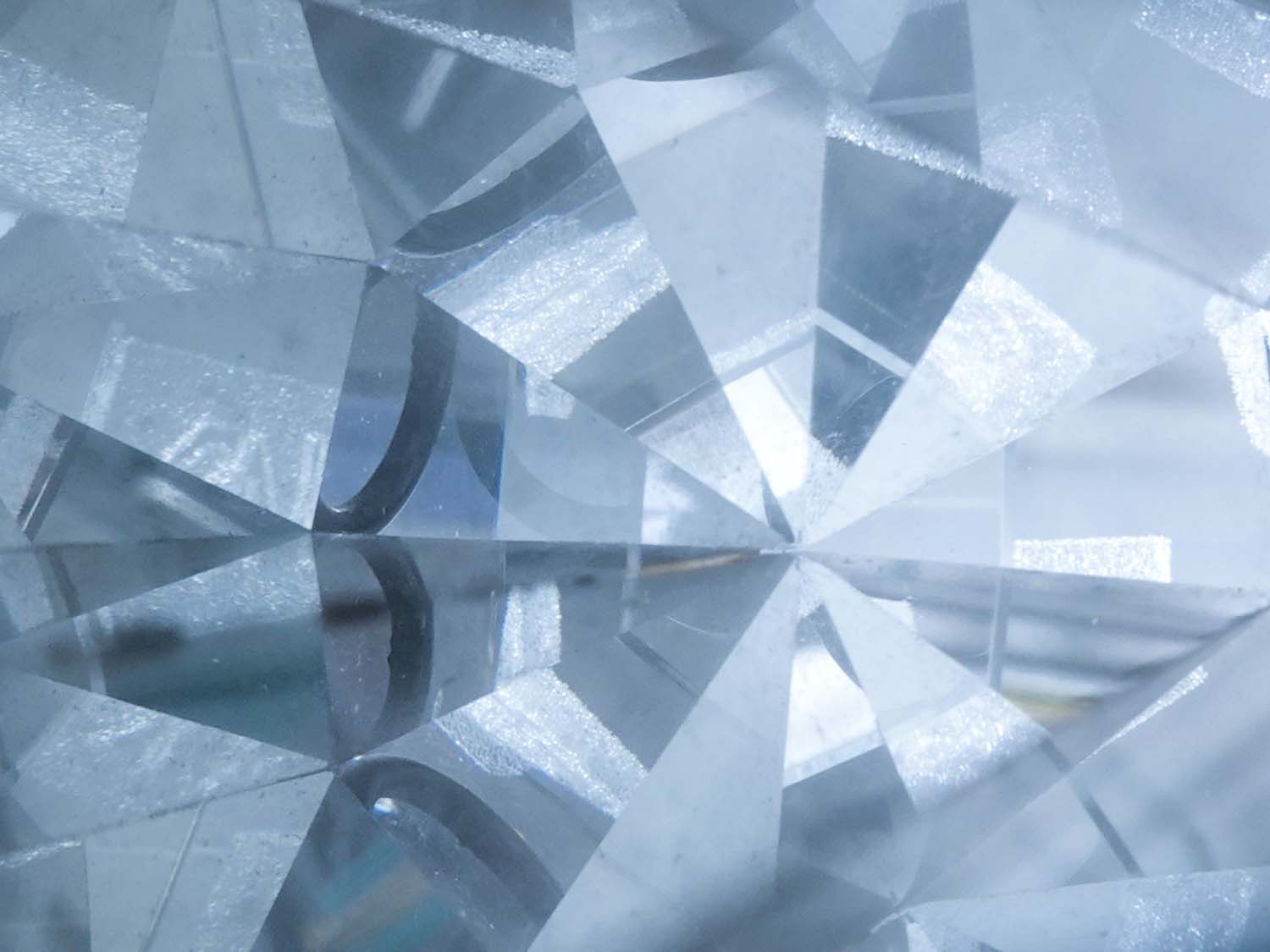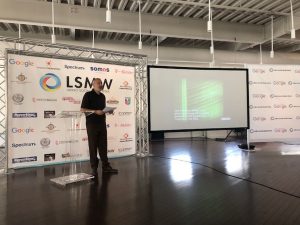Diamond quantum computing is a field of quantum computing that is based on the process called optically detected magnetic resonance with the Nitrogen-vacancy (NV) atom-scale defects in diamond to store quantum bits that hold contradictory data.
Optically active structural defects in diamond offer a promising qubit platform for quantum computing. The trapped electron circulates around the NV center. The spin of this electron can be manipulated to represent a qubit. An NV center is created when a nitrogen atom replaces one carbon atom, and a neighboring carbon atom is removed to form a vacancy within the diamond lattice. At this vacancy, an unpaired electron is trapped.
Ideal quantum diamond observed by measuring a change in fluorescence after shining green light on an NV defect, or on an ensemble of them while scanning an applied microwave field.
Here are a few more specific examples of diamond specifications that may be relevant for use in quantum computing:
Purity: Diamonds used in quantum computing should have a very high level of purity, with minimal impurities or defects. For example, a diamond with a purity of 99.999% or higher may be suitable for use in quantum computing.
Size: Diamonds used in quantum computing are typically quite small, with sizes ranging from a few nanometers to a few micrometers. For example, a diamond with a size of around 2 micrometers may be suitable for use in quantum computing.
Shape: The shape of the diamonds used in quantum computing is also important. Diamonds with a more regular, symmetrical shape are generally preferred, as they are less likely to have defects or impurities that could disrupt the quantum states of the qubits. For example, a diamond with a cubic or octahedral shape may be suitable for use in quantum computing.
Nitrogen-vacancy (NV) centers: Diamonds used in quantum computing should have defects in their crystal structure called nitrogen-vacancy (NV) centers. These defects can be used to create qubits, which are the basic units of quantum information. The concentration of NV centers in the diamond may be an important factor, with higher concentrations generally being preferred. For example, a diamond with an NV center concentration of around 10^16 cm^-3 may be suitable for use in quantum computing.
It’s worth noting that these are just a few examples of specific diamond specifications that may be relevant for use in quantum computing. The specific requirements for diamonds used in a particular quantum computing system may vary depending on the specific needs and requirements of the system.
There are a few different ways that you can determine whether a diamond has nitrogen-vacancy (NV) centers, which are defects in the diamond’s crystal structure that are useful for quantum computing applications:
Visual inspection: One way to look for NV centers is to simply inspect the diamond visually. Diamonds with NV centers may have a yellow or brownish color, which can be visible to the naked eye. However, it’s important to note that not all diamonds with NV centers will exhibit this coloration, and other factors such as the size and shape of the diamond may also affect its appearance.
Photoluminescence: NV centers in diamonds can also be detected using photoluminescence, which is the emission of light when a material is exposed to light of a specific wavelength. Diamonds with NV centers will typically exhibit photoluminescence when exposed to certain wavelengths of light, which can be detected using specialized equipment.
Electron paramagnetic resonance (EPR): Another way to detect NV centers in diamonds is to use a technique called electron paramagnetic resonance (EPR), which measures the response of certain materials to an applied magnetic field. Diamonds with NV centers will exhibit a specific EPR signal that can be detected using specialized equipment.
It’s worth noting that these are just a few examples of methods that can be used to detect NV centers in diamonds. The specific method that is used may depend on the specific needs and requirements of the application, as well as the equipment and resources that are available.
There are a variety of specialized equipment and instruments that can be used to detect photoluminescence in diamonds, which is the emission of light when a material is exposed to light of a specific wavelength ***. Some examples of equipment that may be used for this purpose include:
Fluorescence microscopes: Fluorescence microscopes use a laser or other light source to excite the sample and a detector to measure the resulting fluorescence. These instruments can be used to detect photoluminescence in small samples, such as individual diamonds.
Fluorescence spectrometers: Fluorescence spectrometers use a light source to excite the sample and a spectrometer to measure the resulting fluorescence. These instruments can be used to measure the intensity and wavelength of the fluorescence, and can be used to analyze larger samples or samples in bulk.
Photoluminescence imaging systems: Photoluminescence imaging systems use a light source to excite the sample and a camera or other imaging device to capture the resulting fluorescence. These instruments can be used to create images of the sample, and can be useful for analyzing the spatial distribution of photoluminescence in the sample.
It’s worth noting that these are just a few examples of the types of equipment that can be used to detect photoluminescence in diamonds. The specific equipment that is used may depend on the specific needs and requirements of the application, as well as the available resources and budget.
There are a variety of different brands and manufacturers that produce equipment for measuring photoluminescence in diamonds, including:
Horiba Scientific
Edinburgh Instruments
Renishaw
Ocean Optics
Agilent Technologies
Bruker
Thermo Fisher Scientific
Here are a few examples of brands and manufacturers that produce fluorescence spectrometers and photoluminescence imaging systems:
Fluorescence spectrometers:
Horiba Scientific
Edinburgh Instruments
Renishaw
Ocean Optics
Agilent Technologies
Bruker
Thermo Fisher Scientific
Photoluminescence imaging systems:
Horiba Scientific
Leica Microsystems
Renishaw
Flir Systems
PerkinElmer
Bruker
Thermo Fisher Scientific
It’s worth noting that this is just a small selection of the brands and manufacturers that produce fluorescence spectrometers and photoluminescence imaging systems. There are many other companies that also offer such equipment, and the specific brand or manufacturer that is best suited for your needs will depend on a variety of factors, including the specific equipment you need, your budget, and any other specific requirements or preferences you may have.
Diamonds that are used in quantum computing are typically raw, uncut diamonds. These diamonds are typically quite small, with sizes ranging from a few nanometers to a few micrometers, and they are often shaped in a regular, symmetrical way to minimize defects and impurities. These diamonds are not typically the same as the diamonds used in jewelry, which are typically larger and cut into specific shapes to enhance their appearance.
It is possible to find raw, uncut diamonds at some diamond stores, although they may not be common and may not be suitable for use in quantum computing. These diamonds are typically used for industrial or scientific purposes, rather than for jewelry.
Instead, diamonds used in quantum computing are often sourced from specialized suppliers who specialize in providing high-quality diamonds for this purpose. These suppliers may have relationships with diamond mines or other sources of raw diamonds and may have the expertise and equipment needed to identify and select diamonds with the specific characteristics that are required for use in quantum computing.
There are a number of specialized suppliers that provide diamonds for use in quantum computing. Some examples of companies that may be worth considering include:
Element Six: Element Six is a global company that specializes in producing synthetic diamonds for a variety of applications, including quantum computing.
Diamond Foundry: Diamond Foundry is a company that produces high-quality, synthetic diamonds using a proprietary process. The company’s diamonds are used in a variety of applications, including quantum computing.
Quantum Diamond Technologies: Quantum Diamond Technologies is a company that produces high-quality diamonds for use in quantum computing and other applications.
ISD Technologies: ISD Technologies is a company that specializes in producing high-quality diamonds for use in a variety of applications, including quantum computing.
It’s worth noting that this is just a small selection of the companies that specialize in producing diamonds for use in quantum computing. There are many other companies that may also be worth considering, and the specific supplier that is best suited for your needs will depend on a variety of factors, including your specific requirements and the resources and budget you have available.
Here are a few more examples of companies that specialize in producing diamonds for use in quantum computing:
QD Laser: QD Laser is a company that produces high-quality diamonds for use in quantum computing and other applications.
Single Quantum: Single Quantum is a company that specializes in producing high-quality diamonds for use in a variety of applications, including quantum computing.
ACME Diamond Corp: ACME Diamond Corp is a company that produces high-quality diamonds for use in quantum computing and other applications.
Diamond Materials: Diamond Materials is a company that specializes in producing high-quality diamonds for use in a variety of applications, including quantum computing.
A.L.M.T. Corp: A.L.M.T. Corp is a company that produces high-quality diamonds for use in quantum computing and other applications.
It’s worth noting that this is just a small selection of the companies that specialize in producing diamonds for use in quantum computing. There are many other companies that may also be worth considering, and the specific supplier that is best suited for your needs will depend on a variety of factors, including your specific requirements and the resources and budget you have available.
It’s difficult to give a precise estimate of the value of the market for selling diamonds to the quantum computing industry, as the market is still relatively small and is likely to change significantly over time as the field of quantum computing develops. Additionally, the value of the market may vary depending on a number of factors, including the specific characteristics and quality of the diamonds being sold, the demand for diamonds from different quantum computing applications, and the overall state of the economy.
That being said, it’s likely that the market for diamonds used in quantum computing will continue to grow as the field of quantum computing develops and becomes more widespread. Quantum computers have the potential to solve certain types of problems that are beyond the capabilities of classical computers, and this has led to significant interest and investment in the field. As such, the demand for diamonds used in quantum computing is likely to increase over time, which could lead to growth in the market for these diamonds.
it’s possible that the market for diamonds used in quantum computing could be worth millions or even billions of dollars in the coming years, as the field of quantum computing continues to grow and the demand for these diamonds increases. However, it’s important to note that this is just a rough estimate, and the actual value of the market may be significantly different.
The Harmonized Tariff Schedule (HTS) is a standardized system of codes used to classify goods that are imported into or exported out of countries. Each goods is assigned a specific HTS code based on its characteristics, and the applicable tariff or duty is based on the HTS code assigned to the goods.
It’s worth noting that the HTS codes for diamonds used in quantum computing may vary depending on the specific characteristics of the diamonds and the country where they are being imported or exported. Here are a few examples of HTS codes that may be applicable to diamonds used in quantum computing:
7105.10.00: This HTS code applies to diamonds, whether or not worked, but not mounted or set. This code may be applicable to raw, uncut diamonds that are used in quantum computing.
7105.90.00: This HTS code applies to other diamonds, whether or not worked, but not mounted or set. This code may be applicable to diamonds that are used in quantum computing and have specific characteristics that do not fit into the other HTS codes for diamonds.
7116.20.00: This HTS code applies to articles of jewelry and parts thereof, of precious metal, or clad with precious metal, whether or not set with diamonds or other precious stones. This code may be applicable to diamonds that are used in quantum computing and are mounted or set in a piece of jewelry or other decorative object.
It’s worth noting that these are just a few examples of HTS codes that may be applicable to diamonds used in quantum computing. The specific HTS code that is applicable to a particular set of diamonds will depend on the specific characteristics of the diamonds and the country where they are being imported or exported. It’s always a good idea to consult with a customs broker or other trade specialist to determine the applicable HTS code for your goods.
The Export Control Classification Number (ECCN) is a standardized system of codes that is used to classify goods that are subject to export control regulations. Each ECCN is assigned to a specific category of goods based on the nature of the goods and their potential uses.
It’s worth noting that the ECCN for diamonds used in quantum computing may vary depending on the specific characteristics of the diamonds and the country where they are being exported. Here are a few examples of ECCN categories that may be applicable to diamonds used in quantum computing:
EAR99: This ECCN category applies to goods that are not listed on the Commerce Control List (CCL) and that do not require a license for export from the United States. This category may be applicable to diamonds used in quantum computing that do not have any specific characteristics that would require them to be controlled under a different ECCN.
3A001: This ECCN category applies to materials, equipment, and software that are specifically designed or modified for use in the development, production, or use of nuclear weapons. This category may be applicable to diamonds used in quantum computing that are specifically designed or modified for use in nuclear weapons development.
3E001: This ECCN category applies to materials, equipment, and software that are specifically designed or modified for use in the development, production, or use of chemical or biological weapons. This category may be applicable to diamonds used in quantum computing that are specifically designed or modified for use in chemical or biological weapons development.
It’s worth noting that these are just a few examples of ECCN categories that may be applicable to diamonds used in quantum computing. The specific ECCN that is applicable to a particular set of diamonds will depend on the specific characteristics of the diamonds and the country where they are being exported. It’s always a good idea to consult with a trade specialist or other expert to determine the applicable ECCN for your goods.
There are a variety of buyers of diamonds in the quantum computing arena, including:
Quantum computing companies: Quantum computing companies are likely to be among the main buyers of diamonds used in quantum computing. These companies may use diamonds in the development and production of quantum computers, as well as in other related research and development efforts.
Research institutions: Research institutions, such as universities and government research labs, may also be buyers of diamonds used in quantum computing. These institutions may use diamonds in their own research and development efforts, or they may purchase diamonds for use in research projects funded by external organizations.
Defense contractors: Defense contractors may also be buyers of diamonds used in quantum computing, as they may be interested in using these diamonds in the development of new technologies for military applications.
Industrial companies: Industrial companies in a variety of different sectors may also be buyers of diamonds used in quantum computing, as they may be interested in using these diamonds in the development of new products or technologies.
It’s worth noting that this is just a small selection of the types of buyers that may be interested in purchasing diamonds used in quantum computing. There may be many other types of buyers as well, and the specific buyers that are interested in your diamonds will depend on a variety of factors, including the specific characteristics of the diamonds and the market demand for these diamonds.
There are many different buyers of diamonds used in quantum computing, and it’s not possible to name all of them here. Some examples of companies and organizations that may be buyers of diamonds used in quantum computing include:
IBM
Google
Intel
Microsoft
Honeywell
MIT
Stanford University
National Institute of Standards and Technology (NIST)
Raytheon
Lockheed Martin
Here are a few examples of smaller quantum computing companies that may be interested in purchasing diamonds:
D-Wave Systems: D-Wave Systems is a Canadian quantum computing company that has developed a range of quantum computing products and services.
Rigetti Computing: Rigetti Computing is a US-based quantum computing company that has developed a range of quantum computing products and services.
IonQ: IonQ is a US-based quantum computing company that has developed a range of quantum computing products and services.
Qubit Labs: Qubit Labs is a US-based quantum computing company that has developed a range of quantum computing products and services.
Quantum Circuits: Quantum Circuits is a US-based quantum computing company that has developed a range of quantum computing products and services.
There are several methods that can be used to create and manipulate diamonds at the nanoscale. Some of these methods include:
Chemical vapor deposition (CVD): This is a process in which a diamond film is grown on a substrate using a chemical reaction. By controlling the reaction conditions, it is possible to create diamond films with precise thicknesses and shapes at the nanoscale.
Focused ion beam (FIB) milling: This is a technique in which a beam of ions (atoms with a positive charge) is used to etch away material from a sample. By carefully controlling the beam and the sample, it is possible to create precise shapes and features in diamonds at the nanoscale.
Nanofabrication techniques: There are a variety of techniques that can be used to fabricate structures at the nanoscale, such as electron beam lithography, photolithography, and nanomanipulation. These techniques can be used to create precise patterns and structures in diamonds at the nanoscale.
Natural diamond nanocrystals: Diamond nanocrystals can also be produced naturally, through the high-pressure, high-temperature (HPHT) synthesis of diamond. By carefully controlling the synthesis conditions, it is possible to create diamond nanocrystals with precise sizes and shapes.
In all of these cases, specialized equipment and techniques are used to create and manipulate diamonds at the nanoscale.
There are a number of companies that specialize in cutting, resizing, and preparing diamonds for use in quantum computing and other applications. Some examples of companies that may be involved in these activities include:
Element Six: This is a company that specializes in the production of synthetic diamond materials for a variety of applications, including quantum computing. Element Six has expertise in CVD diamond growth and has developed techniques for creating high-quality diamond materials with precise sizes and shapes.
QD Laser Inc.: This is a company that specializes in the production of quantum dot lasers, which are lasers that use nanoscale semiconductor crystals as the active gain medium. QD Laser has developed techniques for fabricating and manipulating diamond nanocrystals for use in quantum dot lasers.
ID Quantique: This is a company that specializes in the development of quantum technologies, including quantum computers. ID Quantique has expertise in the production and manipulation of diamond nanostructures for use in quantum computing and other applications.
Diamond Materials: This is a company that specializes in the production of diamond materials for a variety of applications, including quantum computing. Diamond Materials has developed techniques for growing and manipulating diamond materials at the nanoscale.
These are just a few examples of companies that may be involved in the production and manipulation of diamonds for use in quantum computing. There are likely many other companies around the world that are also working on these types of activities.
*** The specific wavelength of light that is absorbed or emitted by a diamond depends on the particular energy level transitions that are occurring within the diamond. Diamond is a wide bandgap semiconductor, so it absorbs and emits light over a wide range of wavelengths. The absorption and emission spectra of diamond can be quite complex, with many different transitions occurring at different energies. Some common absorption bands in diamond include the infrared absorption band at around 800 nm, and the visible absorption bands at around 430 nm and 550 nm. Emission from diamond can also occur over a wide range of wavelengths, depending on the excitation source and the specific transition that is occurring.
Quantum computing uses quantum bits, or qubits, to perform calculations. Qubits can be encoded in a variety of physical systems, including photons (particles of light). In this case, the wavelength of the photons can be an important factor in the operation of the quantum computer.
In certain quantum computing architectures, the wavelength of the photons can be used to encode and manipulate qubits. For example, in waveguide-based quantum computing, the wavelength of the photons can be used to define the energy levels of the qubits. In this case, the specific wavelength of the photons would be an important factor in the operation of the quantum computer.
In the context of diamonds with NV centers, the certain wavelengths of light that I mentioned are typically in the visible or near-infrared range. Diamonds with NV centers will typically exhibit photoluminescence when exposed to wavelengths of light in the range of approximately 600 nm to 900 nm.
NV centers are defects in the diamond lattice that can be created by introducing nitrogen atoms into the diamond structure and then subjecting the diamond to high pressure and temperature. NV centers can exhibit both photoluminescence (the emission of light when excited by absorbed light) and electroluminescence (the emission of light when a current is passed through the material). The specific wavelengths of light that are absorbed and emitted by NV centers can depend on the particular energy level transitions that are occurring within the NV centers.
NV centers are of interest for a variety of applications, including quantum computing and sensing, due to their ability to exhibit both photoluminescence and electroluminescence, as well as their ability to be optically initialized and read out.
Diamond quantum computing is a field of quantum computing that is based on the process called optically detected magnetic resonance with the Nitrogen-vacancy (NV) atom-scale defects in diamond to store quantum bits that hold contradictory data.
Optically active structural defects in diamond offer a promising qubit platform for quantum computing. The trapped electron circulates around the NV center. The spin of this electron can be manipulated to represent a qubit. An NV center is created when a nitrogen atom replaces one carbon atom, and a neighboring carbon atom is removed to form a vacancy within the diamond lattice. At this vacancy, an unpaired electron is trapped.
Research: Medyamax Inc.
Credits: Open AI, YouTube LLC.
Image: Daniele Levis Pelusi



